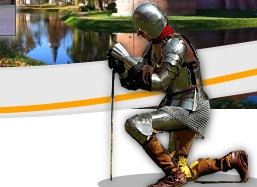| The castle in Nidzica (German Neidenburg)
was built around 1370 by the Grand Master of the Teutonic
Order, Winrich von Kniprode, as one of the major strategic
points in the defence system of the Teutonic state. The Gothic
fortress was raised on a high hill, east of a medieval settlement
and replaced a wooden watchtower fort of the 13th century,
which had stood at the site of the present outer ward of the
castle. The brick castle, surrounded with bogs and vast marshes,
was like a shield for the southern part of the Teutonic state.
It protected numerous villages established by the Order near
the towns of Dąbrówno, Olsztynek and Działdowo against Lithuanian
retaliatory attacks. It also guarded an alternative route
from Masovia to Malbork. The castle was a seat of Teutonic
officials, both commanders (Komtur) and procurators (Prokurator).
Following continual border disputes, a peace conference was
summoned at the castle in Nidzica in 1389. It was attended
by delegates of the Teutonic Order, Poland and Lithuania,
including the Duke of Masovia Ziemowit, the Duke of Lithuania
Skirgiełło, the grand commander Konrad Wallenrod, the Grand
Marshall, the Grand Hospitallier and the bishops of Poznań
and Pomezania.
During the Great War (1409-1410) between the knights and the
Kingdom of Poland and Duchess of Lithuania, on 8th July 1410
the town and the castle of Nidzica were captured by the Polish
king, Władysław Jagiełło. But in September that year the town
was returned to the Teutonic Knights and the peace treaty,
which ended the war, legally confirmed the Knights' ownership.
In 1656 Nidzica was attacked by Tatars, who were on their
way back from the battlefield at Prostki. But the town's gates
were promptly shut down and so the attackers set a camp behind
the town's fortified walls, burning and looting defenceless
suburbs. A young burgher, Jan Nowak, who was then staying
at the castle, noticed the Tartar leader with his companions
as they were sitting and feasting near a huge boulder south-east
of the town. Without hesitation, he loaded and fired a canon,
killing all the banqueters. The loss of the leader caused
panic in the Tartar camp. The town's authorities, fearful
of what might issue of it, ordered to find Jan but he had
already hidden himself in a dung heap. The Tartars, however,
did not strike back. After some time Jan's wife showed his
hiding place and the young man was greeted as a hero. This
is what the legend says.
The chronicles of Nidzica also record the presence of the
French army led by Marshalla Ney, and Bernadotte and by the
generals Augereau and Zajączek; the latter organised a field
hospital at the castle. The second arrival of the French troops
followed by the Don cossacks fighting for the Russian tsar
left the castle badly damaged.
The castle was rescued from oblivion by Ferdinand Gregorovicius,
a privy counsellor, who conducted its restoration. In 1830
the works had been completed and since then the castle housed
offices, private apartments and a prison.
During World War Two, while the Soviet Army were advancing
westwards, the castle was largely damaged. It was restored
in 1959-1965. Today the fortress consists of the great hall,
the gatehouse complex and the 16th century outer ward. The
spacious inner ward enclosed by four wings is flanked by two
impressive corner towers. The first floor (piano nobile) of
the great hall, which comprises the most refined chambers
such as the chapel and refectory, preserves some remnants
of Gothic frescoes.
Over the centuries, Nidzica castle has changed its appearance
and functions. At present it is a seat of the Centre of Culture
in Nidzica. Other institutions which are located under the
castle roof include: the municipal library, the Museum of
the Nidzica region, a modern conference and exhibition hall,
a sculpture workshop, a brotherhood of knights, a gallery
of Henryk Skurpsk's paintings, a travel agency, a hotel and
a restaurant (www.hotelgregorovius.com.pl).
"Mediaeval feasts" held in the castle restaurant
are a special tourist attraction. At such feasts, guests wear
monk cloak and can eat delicacies with their hands. Dances
and shows of knights at combat add variety to each feast,
which usually lasts for several hours. The Gothic castle chambers
also host concerts, art exhibitions, conferences, banquets
and ballroom dances.
The Nidzica Centre of Culture (the
castle)
ul. Zamkowa 2, 13-100 Nidzica, Poland
tel. +4889 635 31 44, e-mail: nidzickiosrodekkultury@poczta.fm
|






![]()
![]() The
project is co-financed from the funds of the European Regional Development Fund,
under the framework of the Lithuania,
The
project is co-financed from the funds of the European Regional Development Fund,
under the framework of the Lithuania,